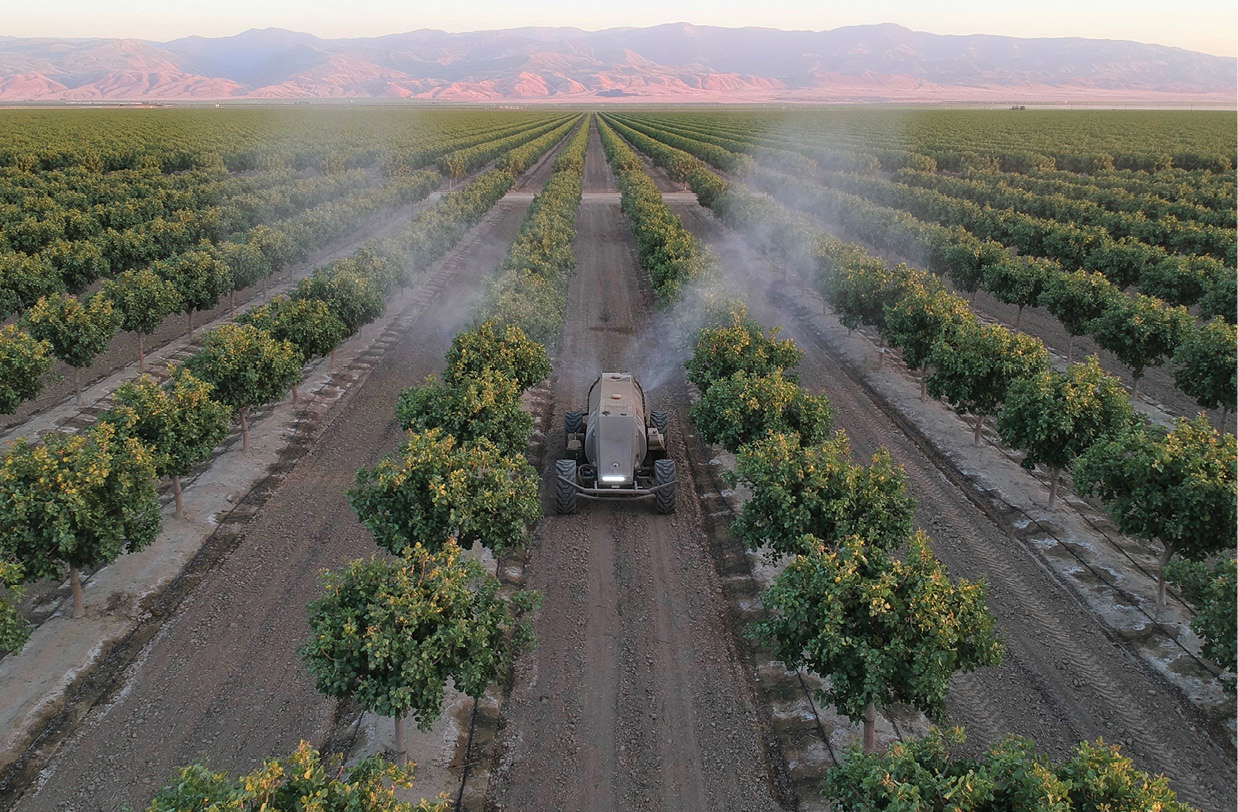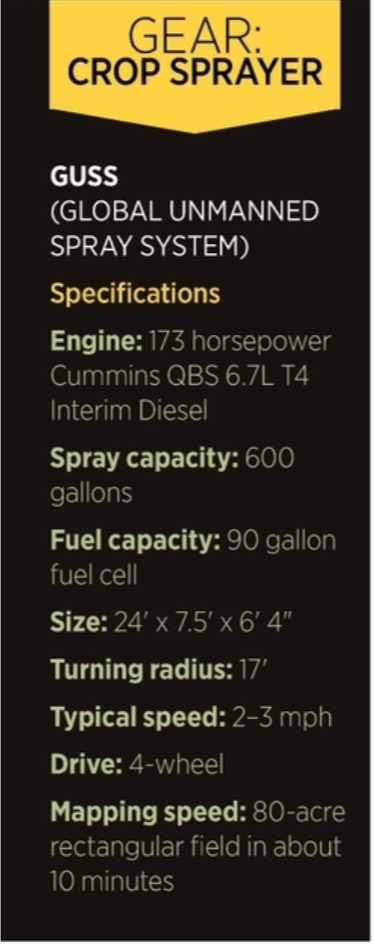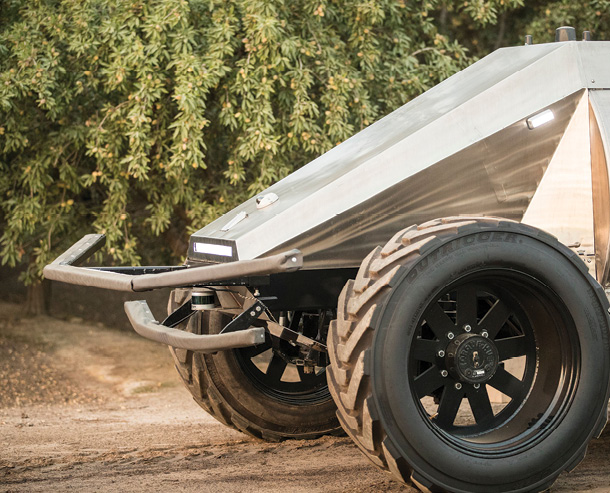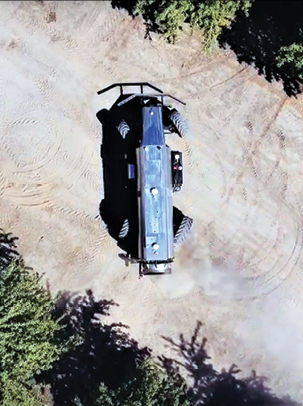
Orchards and vineyards are often not considered to be fertile ground for technology innovation. Yet, for Dave Crinklaw, founder of agriculture technology company GUSS Automation LLC, it’s a world ripe with opportunity.
In 2018, borrowing from advances in vehicle guidance technologies, Crinklaw and his team introduced the Global Unmanned Spray System, or GUSS. This 100 percent unmanned vehicle is uniquely designed to spray in orchards of all shapes and sizes, efficiently and safely managing commercial fertilizer and pesticide applications. Now, Crinklaw’s vision of a global unmanned spray system fleet for orchard management is fast becoming a reality in California, and beyond.
SENSING NEW POSSIBILITIES
Born and raised in the heart of California’s Central Valley, Crinklaw and his father Bob founded Crinklaw Farm Services (now CFS, LP) in 1982 as a commercial fertilizer, pesticide and herbicide application services company. Starting with just two tractors, father and son built a reputation for tree and vine application, mechanical grape harvesting, machine vineyard pruning and soil amendment spreading.
Throughout this time, Crinklaw continually looked for ways to optimize services, specifically spray applications, to increase efficiency and lower costs for producers. He developed the first three- and four-row vineyard sprayers, mechanical vineyard pruners and the advanced Tree-See orchard sprayer—all with an eye toward the driverless sprayer.
 In 2015, concerned about growing labor challenges, Crinklaw began to prototype a driverless orchard sprayer. Very familiar with orchard dimensions after more than 30 years of providing application services, Crinklaw designed GUSS, a custom low-profile shape (6 foot 4 inches tall by 24 feet long by 7.5 feet wide) vehicle built to allow tree branches to flow over it so as to not damage or dislodge fruit from the limbs.
In 2015, concerned about growing labor challenges, Crinklaw began to prototype a driverless orchard sprayer. Very familiar with orchard dimensions after more than 30 years of providing application services, Crinklaw designed GUSS, a custom low-profile shape (6 foot 4 inches tall by 24 feet long by 7.5 feet wide) vehicle built to allow tree branches to flow over it so as to not damage or dislodge fruit from the limbs.
GUSS conformed to its terrain in other ways. Typical orchard rows are between 20 and 22 feet wide, with varying heights because of low-hanging branches; therefore the GUSS could move without need for high-end navigational accuracy. Because orchards are planted in defined row widths, GUSS four-wheel steering and 17-foot turning radius allowed the machine to easily turn from one row to the next. The vehicle featured a Cummins QSB 6.7L 173 horsepower T4 Interim Diesel Engine with a 600-gallon stainless steel tank under a stainless steel hood, roof, engine doors and fan housing. A 90-gallon fuel cell was incorporated.
OPERATIONAL EASE
As GUSS developed, Crinklaw and his engineering team set out to add autonomous guidance and navigation—a considerably bigger technological challenge. GUSS needed to operate reliably and safely as it navigated up and down rows, and it had to “see” potential obstacles while it did. Much like innovators in the autonomous driving space, Crinklaw and company had to combine multiple advanced vehicle sensors and software so it could maneuver autonomously.
Today, GUSS gains precise position and orientation through its use of the Trimble BX992 dual antenna receiver with an integrated inertial navigation system, packaged in a rugged IP67 sealed enclosure built to withstand harsh environments. “We weren’t looking for centimeter positional accuracy from our GNSS receivers,” Chase Schapansky, a mechanical engineer with GUSS Automation LLC, explained. “If we’re within a foot, we’re good.
“More important for us is that the antennas are rugged enough to survive the environment and capable of operating under canopy. The orchard environment is tough on equipment, especially when working among almond trees with low-hanging branches. Antennas are going to have a tough life, but up-time is essential, and we can’t afford breakage in the field.”
Dual antennas also ensure reliable system operation. “With dual antennas, heading accuracy is decided by the separation between the antenna and the positioning engine, not from the velocity of the vehicle,” Schapansky added.
Given the challenge of reliable GNSS under canopy, reliability also comes from multi-constellation GNSS support. “We need as many satellites as possible because we’ll lose at least half as soon as we get into the tree canopy,” Schapansky said. A LiDAR sensor provides guidance and obstacle detection in the absence of a GNSS signal, constantly searching for obstacles in front of the sprayer and immediately stopping the vehicle when it senses a person or object.
In addition to GNSS and LiDAR, GUSS’ wheel and steering sensors send information to the software, with associated algorithms making real-time driving decisions. Those decisions are fed back to the steering and wheel motors to then move GUSS forward. As a backup to the laser, GUSS has a touch-sensitive bumper that shuts the vehicle down when pushed. The vehicle is also equipped with a camera for live-stream video.
All this allows a single employee/operator to remotely monitor up to 10 GUSS sprayers at once across a variety of orchards.

THE VIRTUAL TRUTH
The driverless orchard spraying process begins with a map. The operator pulls up a satellite image of the farm and builds a grid to indicate the estimated driving rows and spacing (e.g., 22 feet). Obstacles such as pumps, power pulls or sheds can be marked on the grid for improved operational safety.
Then a pickup truck or ATV equipped with a GPS receiver drives the perimeter of the orchard for ground truthing, plots the location of vehicle turns and captures center lines for a few rows to verify spacing between tree trunks. Once complete, a virtual fence is added to the orchard map. If GUSS crosses over the virtual fence line for any reason, it will automatically shut down.
“Ground truthing is very quick,” Crinklaw noted. “An 80-acre rectangular field can be done in about 10 minutes. Obviously, a ranch with irregular shapes or more acreage will take a little longer. Once the map is saved, it is good for the life of the orchard.” The process prevents redundant spraying, providing both health and cost benefits.
During spraying, GUSS is monitored by an operator in a pickup who can see the vehicles as they move through the field. Cellular or radio signals are continuously transmitted between the control vehicle and sprayers, relaying position data, machine vital statistics and the live video. Again, if the operator sees any indication of a problem, he can remotely shut the vehicle down.
The operator also sets spray parameters such as gallons per acre and vehicle speed (typically two or three miles per hour). The route is calibrated so GUSS will stop on an avenue before it runs out of material. All data for each spray is recorded with rates applied and date and time of spray. This saved data can be downloaded to a thumb drive and accessed by the grower.
From flow rates to vehicle speed, the entire fertilizer and pesticide application process is controlled, precise and monitored, ensuring consistent orchard coverage and offering improved productivity, efficiency and safety. “The growers,” Crinklaw added, “now have clear documentation about the type and quantity of spray applied at any given time—invaluable data in an increasingly regulated environment.”

SCALING
Since its first test drive in 2018, CFS, LP has used GUSS extensively as part of its orchard management services. Others are adopting it, especially because it addresses a continuing challenge in the industry—labor shortages. With interest on the rise, GUSS Automation, LLC recently moved to a new manufacturing facility in Kingsburg, California, which can produce more than 200 sprayers per year.
Ryan Boucher, owner of Blair Air & Ground Services, Inc., an agricultural seeding and spraying company in Lemoore, California, decided to purchase GUSS sprayers as soon as he heard they were available for sale. “Adding GUSS sprayers to our fleet has greatly increased our efficiency in the field,” he said. “We are experiencing a 30 to 35 percent increase in acres sprayed per day versus our conventional tractors.”
Boucher also noted that the system is very easy to operate and that his existing spraying employees were running their GUSS sprayers completely on their own after only one day of training. With GUSS, he said, he also no longer has to worry about tractor drivers being exposed to the applied materials.
GUSS users are also realizing improved efficiency because there’s no need for breaks—even refilling the tank is done in the field with a nurse truck. “GUSS is more efficient, precise, and safer than my conventional equipment,” Boucher agreed. “It definitely makes my life easier.”

